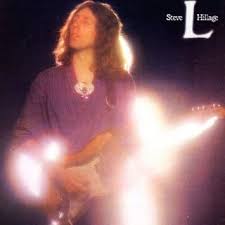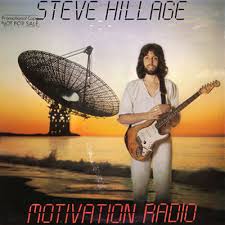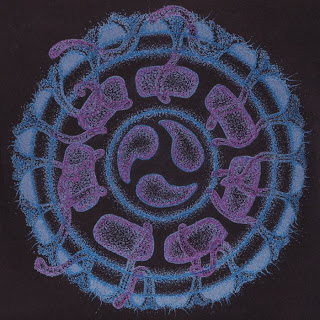
The ambient techno music of the first half of the 1990s owed a lot, thematically, to space rock of the early 1970s. Yet the number of people who have worked significantly in both genres can – and we welcome corrections here – be pretty much counted on the fingers of one finger.
So step forward, Steve Hillage. The Chingford man is an underappreciated craftsman whose fluid, clever guitar-playing was illuminating the Canterbury scene in 1970 with Gong and, as System 7, was gracing sophisticated, velvety ambient in partnership with Detroit techno legends like Derrick May 25 years later and beyond.
Born in Essex in 1951, Hillage was in a school band that would go on to be Egg, a moderately successful prog rock group that served as something of stable for Canterbury scene figures. In 1968, he moved to Canterbury to study at the University of Kent. It was fertile ground for a young musician: Hillage played occasionally with Caravan and Spirogyra;  and Caravan’s manager got Hillage signed to Deram (Decca Records’ prog offshoot) on the strength of demo material with Egg. Hillage put together a band, Khan, with vocalist Nick Greenwood – who had already been in The Crazy World Of Arthur Brown. They played some gigs supporting Caravan and began recording their debut in 1972, but Hillage and Greenwood fell out over direction, while the label lost interest.
and Caravan’s manager got Hillage signed to Deram (Decca Records’ prog offshoot) on the strength of demo material with Egg. Hillage put together a band, Khan, with vocalist Nick Greenwood – who had already been in The Crazy World Of Arthur Brown. They played some gigs supporting Caravan and began recording their debut in 1972, but Hillage and Greenwood fell out over direction, while the label lost interest.
Hillage tinkered with the line-up, with a variety of Canterbury scene musos coming and going – including former school pal Dave Stewart (not the Eurythmics one). Together he and Hillage wrote a track called ‘I Love Its Holy Mystery’, which would go on to form the basis of Hillage’s masterpiece, ‘Solar Musick Suite’. However, it wasn’t really working out for Khan and the band broke up in autumn 1972.
Hillage soon hooked up with Kevin Ayers, late of Soft Machine, and played on his fourth album Bananamour, before joining the Anglo-French psychedelic band Gong and getting together with its keyboardist, Miquette Giraudy. His silky, spacey guitar playing illuminated Gong’s best work, recorded from 1973-1974, on the Gnome Trilogy.
recorded from 1973-1974, on the Gnome Trilogy.
Around this time, he also performed on a live version of Tubular Bells for Mike Oldfield. When Daevid Allen, the Aussie co-founder of Gong and general top banana, left the band (Allen refused to go on stage at a Cheltenham gig in 1975, because there was “a wall of force” preventing him; well we’ve all been there haven’t we), Hillage and Giraudy picked up the reins for a bit, but eventually went their own way.
Hillage was inspired by the success of his Fish Rising debut solo LP – check out the aforementioned Solar Musick Suite off this; a piece of music he would periodically re-work in a live setting. Fish Rising would set the template for this period – hypnotic riffs shaped like an aural music mantra backed with a jazzy but tight band. He had evolved away from the loopy anarchy of Gong into more formal song structures but kept the trippy, cosmic elements.
This was beautiful guitar music. Hillage had his own unique tone, derived from a small armoury of effects pedals as he strove to create music that ever better expressed the truly cosmic nature of the songs subject matter. With keyboard genius Tim Blake onboard doing inter-stellar synth and sequencer sounds, it was a breath-taking debut that found a home in many a greaks household. However, that easy, hippy categorisation of the music is to under-estimate its radical nature. This was ambient music, as hip and as original as anything the more critically acclaimed Fripp and Eno were doing.  The difference was Hillage with his long hair and tea-cosy hat, often dressed in an orange boiler suit, looked straight out of 1968 and the ever fashion-conscious, uptight British press found that uncool. Plus, Hillage played guitar solos, really long, really brilliant guitar solos that would soar and soar and take the top of your head right off. Yet Hillage was a reluctant guitar hero, shying away from the status awarded to him by his fans. This wasn’t cock rock, after all.
The difference was Hillage with his long hair and tea-cosy hat, often dressed in an orange boiler suit, looked straight out of 1968 and the ever fashion-conscious, uptight British press found that uncool. Plus, Hillage played guitar solos, really long, really brilliant guitar solos that would soar and soar and take the top of your head right off. Yet Hillage was a reluctant guitar hero, shying away from the status awarded to him by his fans. This wasn’t cock rock, after all.
Fish Rising, for a radical album, did well reaching 33 in UK charts in May 1975. It features his classic, Salmon Song, an eight minute piece built around a typically hypnotic Hillage riff; it would feature in his live shows for years.
Suitably encouraged by the response to the album, Hillage embarked on its follow-up in 1976 as punk began to break across the UK. For this project, he abandoned his Gong/Canterbury family and recorded the album, eventually called L with members of Todd Rundgren’s Utopia.  It is a different sound all together, still magical, but far more direct, less spacey and with more jazz elements, indeed Jazz legend Don Cherry features on this New York-recorded gem.
It is a different sound all together, still magical, but far more direct, less spacey and with more jazz elements, indeed Jazz legend Don Cherry features on this New York-recorded gem.
While the covers of Its All Too Much and Hurdy Gurdy Man would become live favourites, the stand out tracks are Hillage originals, Lunar Musick Suite and Electric Gypsies, the latter being a virtual manifesto for Hillage’s philosophy and outlook at the time.
The more straight forward sound proved more commercial and it peaked at 10 in October 1976.
Despite punk rock claiming Hillage’s music as irrelevant, with a touch of bloody-mindedness, the 1977 album Motivation Radio saw him fully embrace even more far-out themes and notions. He fully deployed his ‘glissando guitar’ sound for this album, laying down much of it on 7/7/77 for presumably cosmic reasons.  The disc was produced by Malcolm ‘Tonto’s Expanding Head Band’ Cecil, so there is much synth bubble and squeak throughout. But if fans thought this was pretty you-roll-em-I’ll-smoke-‘em, Green, its follow-up was properly far out, cosmic and solid, co-produced by Nick Mason of Pink Floyd. Naturally, it came on green vinyl. Ambient-wise this is a rich, densely layered sound that embraces and submerges you into its uplifting world of light, rhythm and melody.
The disc was produced by Malcolm ‘Tonto’s Expanding Head Band’ Cecil, so there is much synth bubble and squeak throughout. But if fans thought this was pretty you-roll-em-I’ll-smoke-‘em, Green, its follow-up was properly far out, cosmic and solid, co-produced by Nick Mason of Pink Floyd. Naturally, it came on green vinyl. Ambient-wise this is a rich, densely layered sound that embraces and submerges you into its uplifting world of light, rhythm and melody.
It is topped off by perhaps his riff of all riffs; a towering Buddha of a riff that circles around itself, drawing you in, through, up and across your consciousness. The Glorious Om Riff deserves wider recognition as one of guitar music’s most titanic creations.
Still charting in the low 20s and 30s, Hillage next released a live album,’ Live Herald’ which is a great sampler of his best stuff and reflects accurately how hypnotic the live Hillage experience could be. But this was to be the end of an era, as he went off into less song and guitar riffage-based music and further into soundscapes.
In 1979, he released the ground-breaking, proto-ambient LP Rainbow Dome Musick
Hillage was already proving himself a producer of verve and sophistication, and when Punk saw him fall out of fashion– although he himself embraced the new wind blowing through British music, recording punk-ish tracks like ‘1988 Aktivator’ and ‘Getting In Tune’ on his 1979 LP Open – a move behind the controls proved fruitful.
He produced for Simple Minds, It Bites, Murray Head and others throughout the 1980s. But it was a chance meeting that ignited Hillage’s second career. He heard a chill-out DJ playing Rainbow Dome Musick at a club, and introduced himself to the bloke, who turned out to be The Orb’s Alex Paterson, and a friendship and partnership was born.
With Giraudy, he formed the blissfully spacey and really quite brilliant ambient outfit System 7, legends of the chill-out scene in London throughout the 1990s. The sort of inventive and whacked- out, yet always perfectly judged, guitar playing and facility for mood creation that had lit up his work with Gong was still all there, and the System 7 sound system was a guaranteed top trippy night out for many years. Various UK club big noises like Paterson and Paul Oakenfold have contributed, as have titans of the Detroit sound like Derrick May and Carl Craig.
 Probably the best System 7 album is 1996’s Power Of Seven, although the 1994 LP Point 3 is also a very cool project. It featured two totally different mixes of the same tracks: Fire Album (dance beats) and an almost beat-less ambient version, Water Album. ‘Mysterious Traveller’ and ‘Overview’ – in league with Derrick May – on the Fire one are absolute corkers.
Probably the best System 7 album is 1996’s Power Of Seven, although the 1994 LP Point 3 is also a very cool project. It featured two totally different mixes of the same tracks: Fire Album (dance beats) and an almost beat-less ambient version, Water Album. ‘Mysterious Traveller’ and ‘Overview’ – in league with Derrick May – on the Fire one are absolute corkers.
For those who like their techno a bit more down and dirty, check out Plastikman’s mix of System 7’s ‘Alpha Wave’ – a 303-tweaking classic. 1997’s Golden Section LP c ontained a couple of cool tracks – ‘Don Corelone’ with Talvin Singh and recordings of old collaborator Don Cherry, for instance. Hillage and System 7 continue to produce their warm and skilful blend of ambient loveliness to this day, launching a beat-free side project called Mirror Intent in 2006.
Hillage always was a reluctant guitar hero –and so,  while other less talented but more publicity keen players gained far more acclaim and far bigger riches, Hillage’s contributions to the genre have gone over-looked for way too long. He can rightly claim to have created some of the most startlingly original 6 string manifestations in rock history and is virtually peerless in the ambient-rock genre.
while other less talented but more publicity keen players gained far more acclaim and far bigger riches, Hillage’s contributions to the genre have gone over-looked for way too long. He can rightly claim to have created some of the most startlingly original 6 string manifestations in rock history and is virtually peerless in the ambient-rock genre.
A man of tremendous taste, power, poise and articulation in his music, and by all accounts, a splendid chap too, Steve Hillage continues to take us to places above and beyond this mortal coil.





1 comment:
"The ambient techno music of the first half of the 1990s owed a lot, thematically, to space rock of the early 1970s. Yet the number of people who have worked significantly in both genres can – and we welcome corrections here – be pretty much counted on the fingers of one finger."
Make that at least 2: have a look into the work of Manuel Goettsching (Ash Ra Tempel, Ashra). Chances are you'd like it if you like Hillage's.
Post a Comment